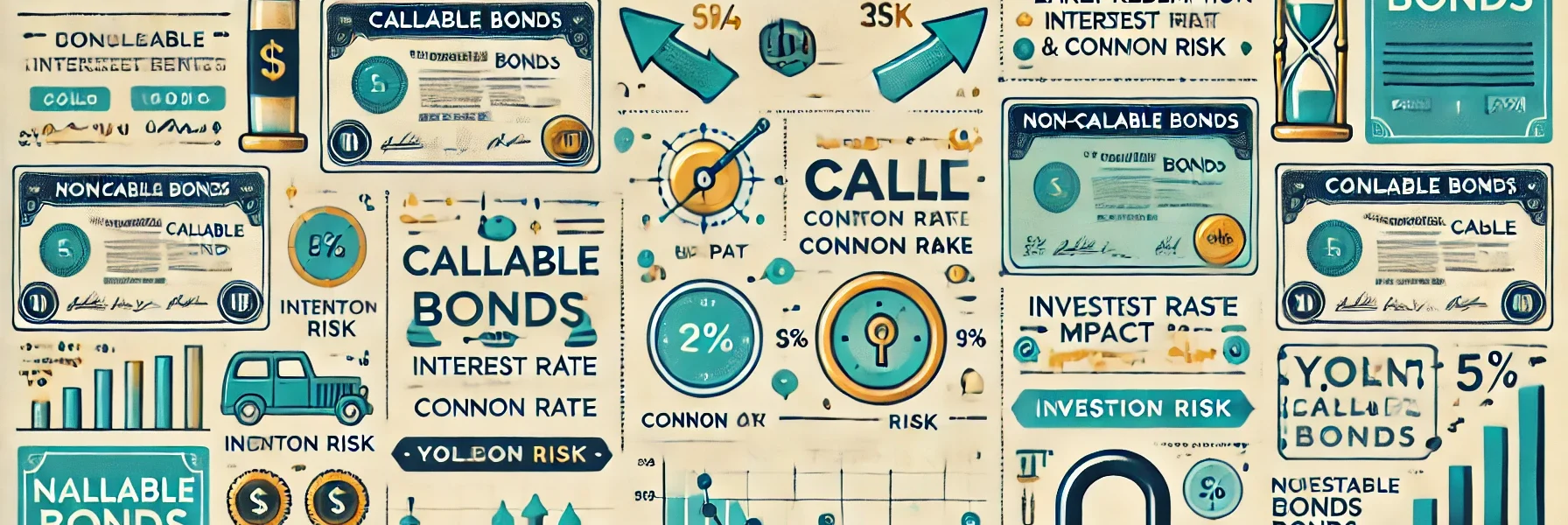Investing in bonds is a popular strategy for generating steady income and preserving capital. However, not all bonds are created equal. One critical distinction investors must understand is the difference between callable bonds and non-callable bonds. Each type offers unique benefits and risks that can significantly impact your investment returns and strategy.
In this comprehensive guide, we will explore the key differences between callable and non-callable bonds, how they work, and the implications they have on your investment portfolio.
What Are Callable Bonds?
Callable bonds are bonds that allow the issuer to redeem (“call”) the bond before its maturity date. This means the issuer can repay the principal amount to bondholders and stop future interest payments. Issuers typically exercise this option when interest rates decline, allowing them to refinance their debt at a lower cost.
How Callable Bonds Work:
- Issuance: A company or government issues callable bonds to raise capital.
- Call Provision: The bond includes terms specifying when and how the issuer can call the bond.
- Call Date: After a specific period (usually a few years), the issuer gains the right to redeem the bond.
- Call Price: The price at which the bond is redeemed, often slightly higher than the face value.
Example of a Callable Bond:
A corporation issues a 10-year callable bond with a 5% coupon rate. If interest rates fall to 3% after five years, the issuer may call the bond and refinance by issuing new bonds at the lower rate.
What Are Non-Callable Bonds?
Non-callable bonds, on the other hand, do not grant the issuer the option to redeem the bond before its maturity. Investors receive consistent interest payments until the bond reaches its predetermined maturity date, regardless of interest rate fluctuations.
How Non-Callable Bonds Work:
- Issuance: A company or government issues non-callable bonds to secure long-term funding.
- Fixed Maturity: Bondholders receive interest payments until the maturity date.
- No Early Redemption: The issuer cannot repay the bond early, providing greater certainty to investors.
Example of a Non-Callable Bond:
A government issues a 15-year non-callable bond with a 4% coupon rate. Bondholders will receive fixed interest payments every year until the 15-year maturity date, regardless of market conditions.
Key Differences Between Callable and Non-Callable Bonds
| Feature | Callable Bonds | Non-Callable Bonds |
|---|---|---|
| Early Redemption | Issuer can redeem before maturity | No early redemption allowed |
| Interest Rates Impact | Issuer calls when rates decline | Not affected by falling interest rates |
| Coupon Rate | Generally higher to compensate for call risk | Lower due to reduced risk for investors |
| Investment Risk | Higher due to call uncertainty | Lower with fixed interest until maturity |
| Yield to Maturity (YTM) | Can be reduced if bond is called early | Fixed and predictable returns |
| Investor Appeal | Attractive in rising-rate environments | Suitable for those seeking stability |
Advantages and Disadvantages of Callable Bonds
Advantages:
- Higher Coupon Payments: To attract investors, issuers offer higher interest rates.
- Potential for Early Liquidity: If called, investors receive the principal earlier than expected.
- Diversification: Adds variety to a fixed-income portfolio.
Disadvantages:
- Call Risk: Bonds may be redeemed before maturity, reducing future income.
- Reinvestment Risk: Investors may have to reinvest at lower rates if the bond is called.
- Uncertain Yields: The actual return may be lower if the bond is called early.
Advantages and Disadvantages of Non-Callable Bonds
Advantages:
- Predictable Income: Fixed payments ensure stable cash flow.
- Reduced Risk: No call risk means returns are more certain.
- Long-Term Stability: Ideal for conservative investors.
Disadvantages:
- Lower Yields: Offers lower interest rates compared to callable bonds.
- Inflation Risk: Fixed payments may lose purchasing power over time.
- Liquidity Constraints: Investors are locked in until maturity unless sold on the secondary market.
Investment Impact: How to Choose Between Callable and Non-Callable Bonds
When deciding between callable and non-callable bonds, consider these factors:
- Interest Rate Outlook:
- If rates are likely to rise, callable bonds may offer better yields.
- In a declining rate environment, non-callable bonds provide stability.
- Risk Tolerance:
- If you prefer predictable returns, non-callable bonds are safer.
- If you can tolerate call and reinvestment risks, callable bonds offer higher returns.
- Investment Goals:
- Long-term investors seeking stable income may prefer non-callable bonds.
- Short-term investors willing to accept some uncertainty may choose callable bonds.
- Diversification Strategy:
- A mix of callable and non-callable bonds can balance risk and return.
Practical Tips for Bond Investors
- Understand Call Provisions: Carefully review the bond’s call dates, call price, and conditions.
- Monitor Interest Rates: Stay informed about rate movements that may trigger bond calls.
- Diversify Holdings: Spread investments across callable and non-callable bonds.
- Use Bond Funds: Bond mutual funds and ETFs can provide diversified exposure to both types of bonds.
- Consult a Financial Advisor: Seek professional advice to align bond investments with your financial goals.
Conclusion
Both callable and non-callable bonds play vital roles in a diversified investment portfolio. While callable bonds offer higher yields with added risk, non-callable bonds provide safety and predictable returns. By understanding the differences and assessing your financial goals, you can make informed decisions that align with your investment strategy.
Whether you seek the stability of non-callable bonds or the higher returns of callable bonds, a balanced approach can help you navigate the complexities of the bond market and achieve long-term financial success.




